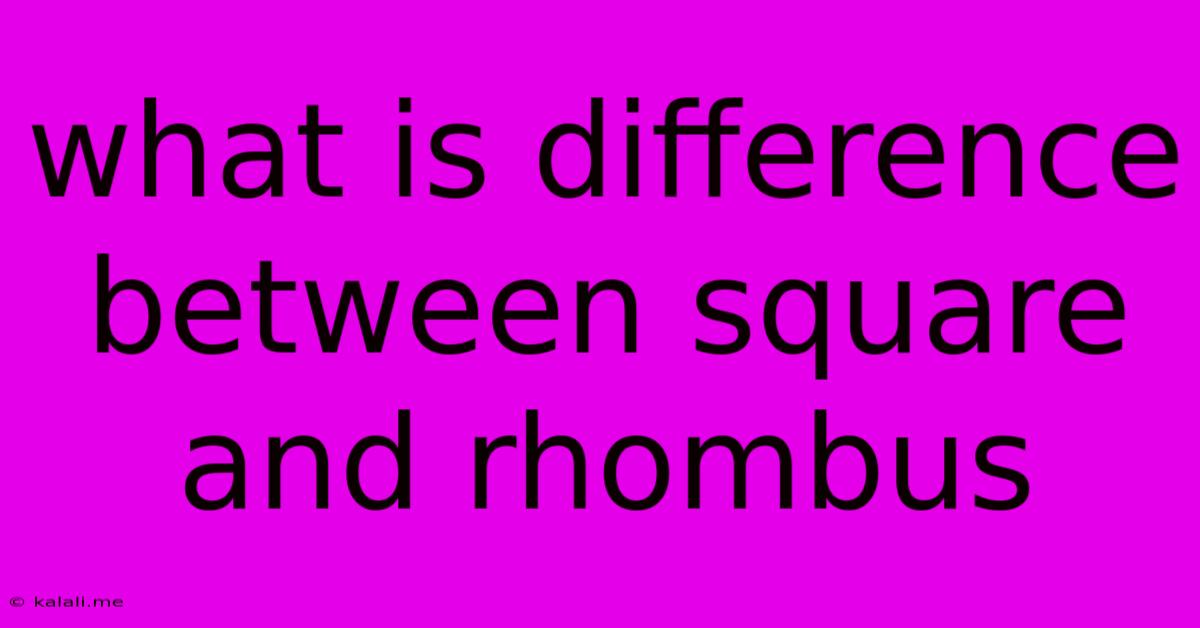What Is Difference Between Square And Rhombus
Kalali
Jun 15, 2025 · 3 min read

Table of Contents
What's the Difference Between a Square and a Rhombus? A Simple Explanation
Understanding the differences between a square and a rhombus can seem tricky at first, but it's easier than you think! Both shapes are quadrilaterals – four-sided polygons – but they have key distinctions that set them apart. This article will break down the differences clearly, helping you confidently identify each shape. We'll explore their properties, angles, and sides to highlight the core discrepancies.
Key Differences: A Quick Overview
The main difference lies in their angles and side lengths. A square is a special type of rhombus where all angles are equal (90 degrees), while a rhombus can have angles that vary, though opposite angles remain equal. Let's delve deeper into the specifics.
Properties of a Square
- Four equal sides: All sides of a square have the same length.
- Four right angles: Each of the four interior angles measures exactly 90 degrees.
- Opposite sides are parallel: The opposite sides of a square are parallel to each other.
- Diagonals are equal and perpendicular bisectors: The diagonals of a square are equal in length and bisect each other at a right angle.
- A square is a special type of rectangle and a special type of rhombus: This means it possesses all the properties of both rectangles and rhombuses.
Properties of a Rhombus
- Four equal sides: Similar to a square, all four sides of a rhombus are of equal length.
- Opposite angles are equal: Opposite angles within a rhombus have the same measure.
- Opposite sides are parallel: Just like a square, opposite sides of a rhombus are parallel to each other.
- Diagonals bisect each other at right angles: The diagonals of a rhombus intersect at a 90-degree angle and cut each other in half.
- Consecutive angles are supplementary: Any two angles next to each other in a rhombus add up to 180 degrees.
Summarizing the Differences
| Feature | Square | Rhombus |
|---|---|---|
| Sides | 4 equal sides | 4 equal sides |
| Angles | 4 right angles (90 degrees each) | Opposite angles are equal; not necessarily 90 degrees |
| Diagonals | Equal in length, perpendicular bisectors | Bisect each other at right angles |
| Shape | Always symmetrical | Can be asymmetrical (unless it's a square) |
Illustrative Examples
Imagine a tile on your floor: if it's perfectly square, all its sides are equal, and all its corners are right angles. Now, think of a diamond shape. It could be a rhombus – all four sides are the same length, but the angles aren't necessarily 90 degrees. A square is always a rhombus, but a rhombus is only a square if it also has four 90-degree angles.
This detailed comparison should clarify the distinctions between squares and rhombuses. Remember, a square is a specialized type of rhombus with the added condition of having right angles. Understanding these geometrical properties is fundamental in various fields, from mathematics and engineering to design and architecture.
Latest Posts
Latest Posts
-
Kabir Das Dohe In Hindi With Meaning
Jun 15, 2025
-
A Generator Is A Device That Converts
Jun 15, 2025
-
Which Of The Following Cells Are Producing Antibodies
Jun 15, 2025
-
Which Of The Following Is A Colloid
Jun 15, 2025
-
Whats The Widest River In The World
Jun 15, 2025
Related Post
Thank you for visiting our website which covers about What Is Difference Between Square And Rhombus . We hope the information provided has been useful to you. Feel free to contact us if you have any questions or need further assistance. See you next time and don't miss to bookmark.